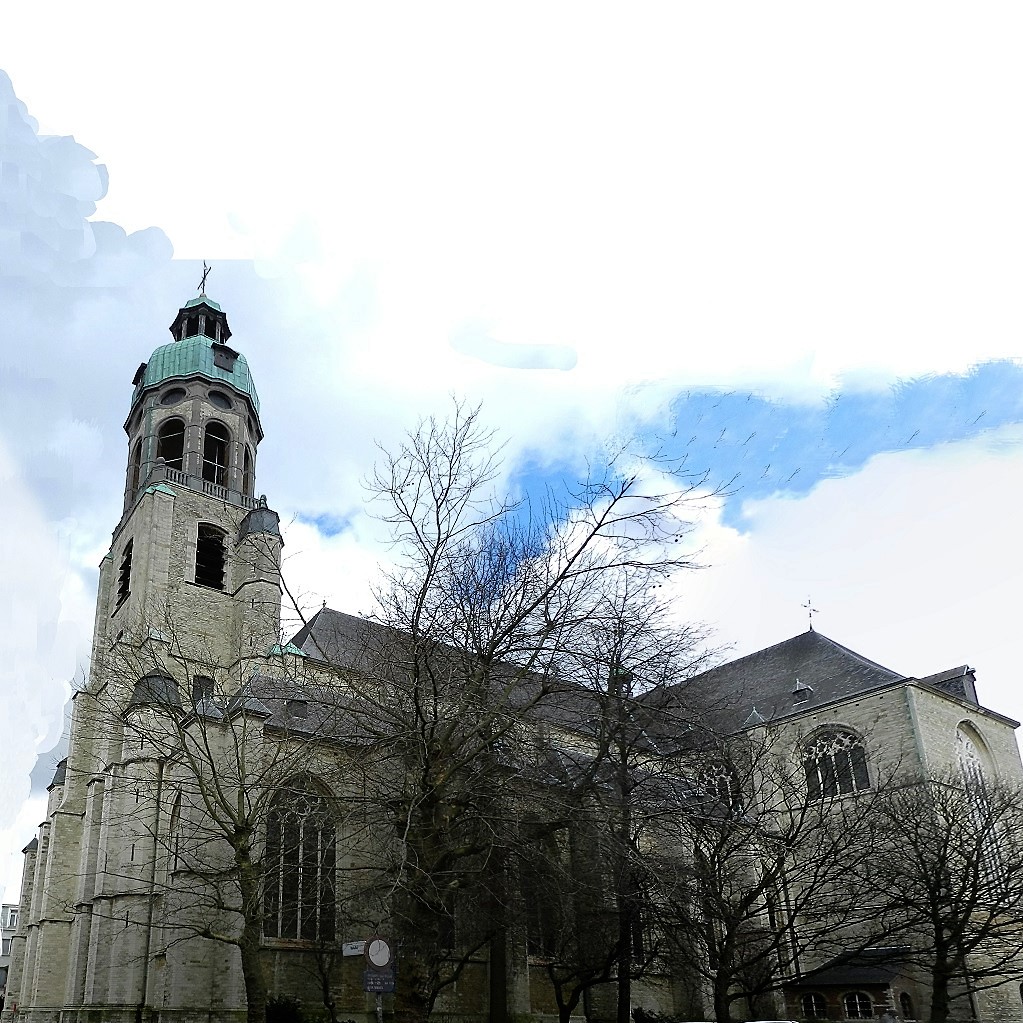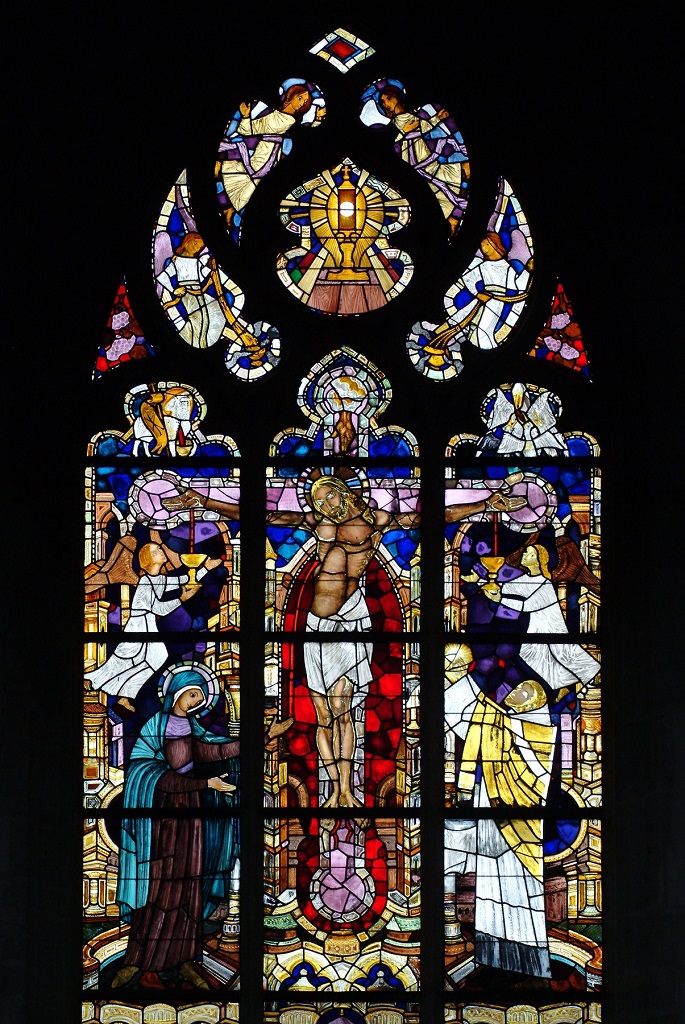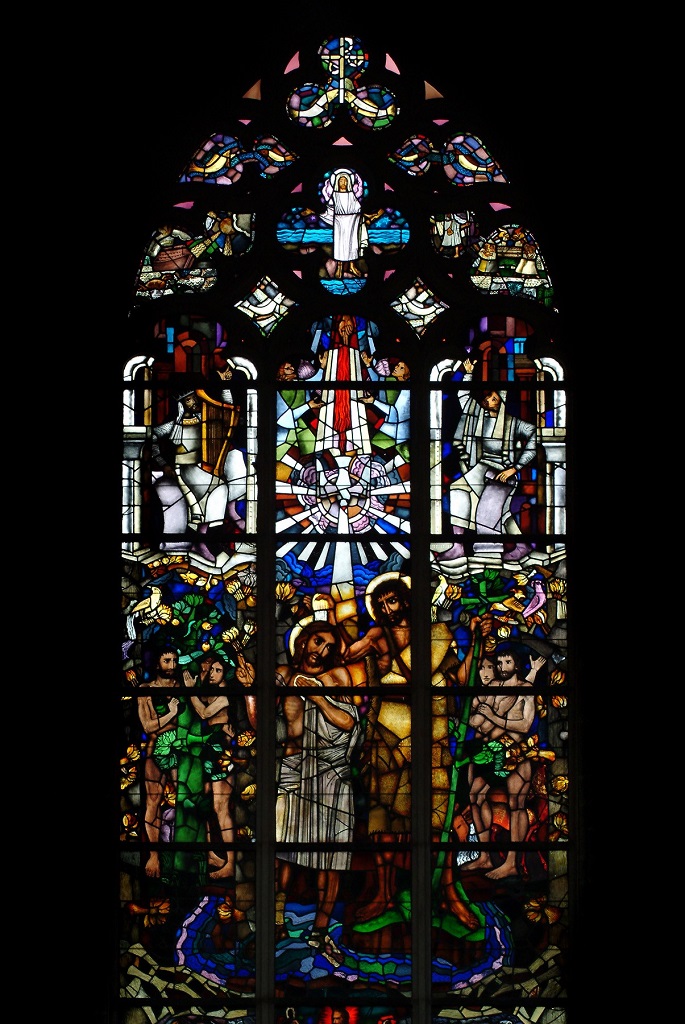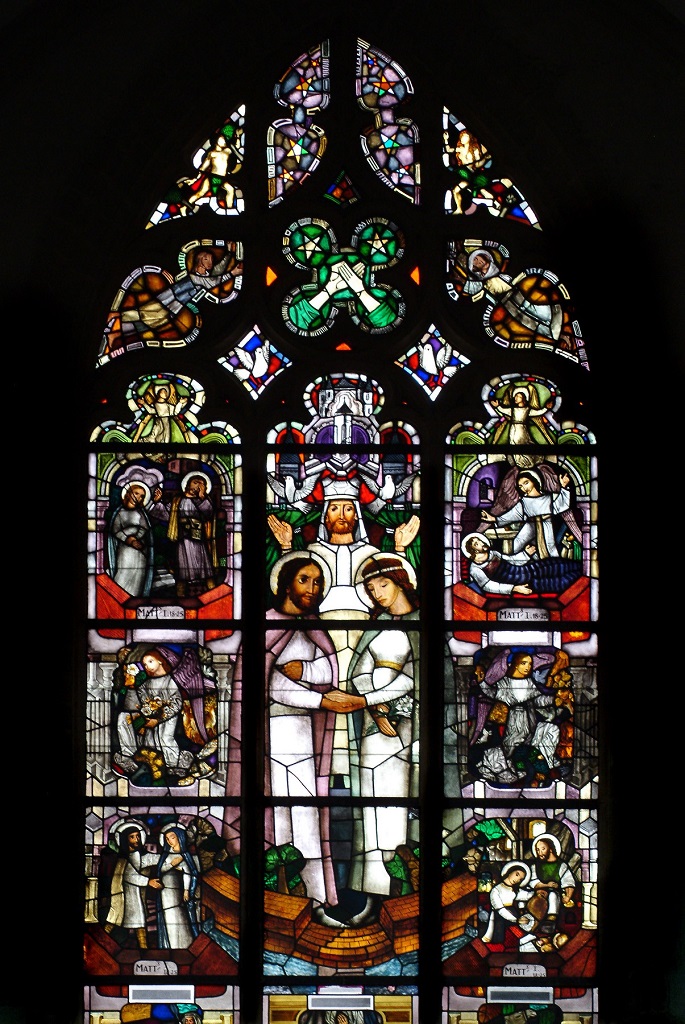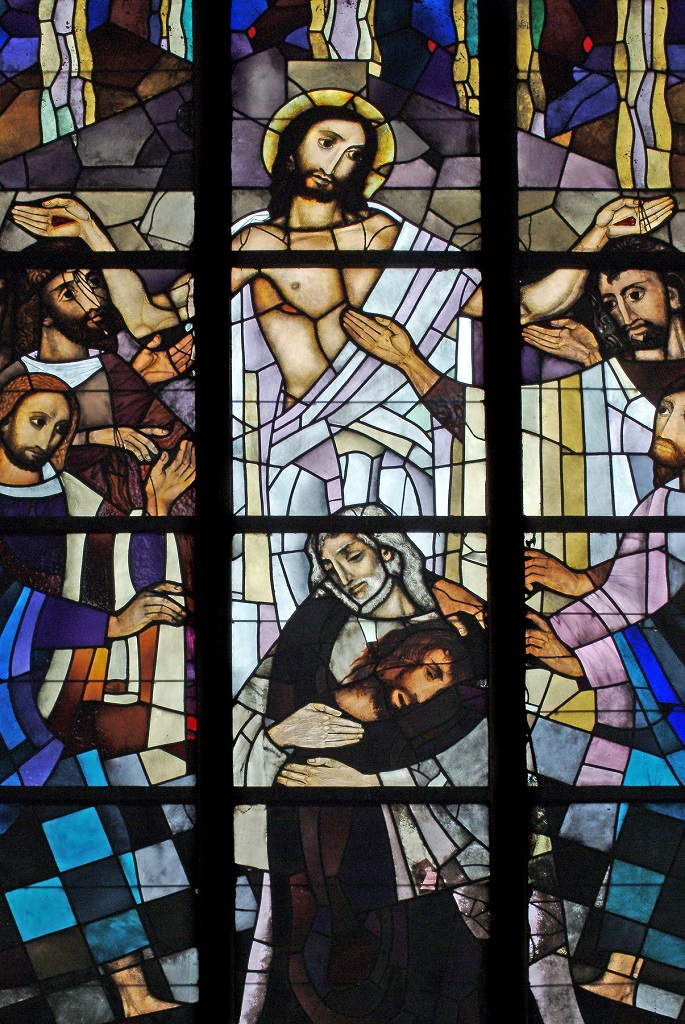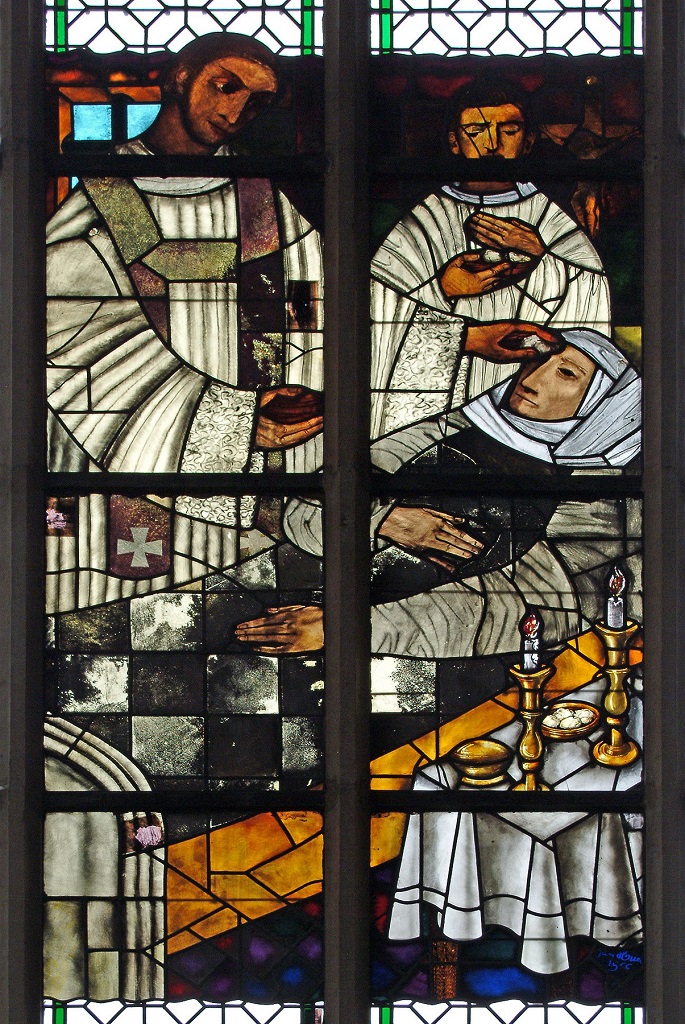Antwerp's St Andrew's Church, a revelation.
The stained glass windows in the northern aisle:
the Seven Sacraments
On 2nd January 1945 a V-bomb struck nearby Vrijdagmarkt. As a result all stained-glass windows in the northern aisleLengthwise the nave [in exceptional cases also the transept] of the church is divided into aisles. An aisle is the space between two series of pillars or between a series of pillars and the outer wall. Each aisle is divided into bays. and northern transeptThe transept forms, as it were, the crossbeam of the cruciform floor plan. The transept consists of two semi transepts, each of which protrudes from the nave on the left and right. were shattered. The war damage gave stained-glass artist Jan Huet the opportunity to work out a grand project around the theme of the Seven Sacraments, on the basis of Biblical pericopes, in 1963-1966. Each sacramentIn Christianity, this is a sacred act in which God comes to man. Sacraments mark important moments in human life. In the Catholic Church, there are seven sacraments: baptism, confession, Eucharist, confirmation, anointing of the sick, marriage and ordination. has been given a symbolic key colour.
One sacrament is depicted in the northern transept, the other six sacraments follow one another from east to west in the northern aisle:
- As the Holiest Sacrament the EucharistThis is the ritual that is the kernel of Mass, recalling what Jesus did the day before he died on the cross. On the evening of that day, Jesus celebrated the Jewish Passover with his disciples. After the meal, he took bread, broke it and gave it to his disciples, saying, “Take and eat. This is my body.” Then he took the cup of wine, gave it to his disciples and said, “Drink from this. This is my blood.” Then Jesus said, “Do this in remembrance of me.” During the Eucharist, the priest repeats these words while breaking bread [in the form of a host] and holding up the chalice with wine. Through the connection between the broken bread and the “broken” Jesus on the cross, Jesus becomes tangibly present. At the same time, this event reminds us of the mission of every Christian: to be “broken bread” from which others can live. is given a place of honour in the big window of the northern transept. The Institution of the Eucharist at the Last Supper is the main scene from the New TestamentPart of the Bible with texts from after the birth of Jesus. This volume holds 4 gospels, the Acts of the Apostles, 14 letters of Paul, 7 apostolic letters and the Book of Revelation (or Apocalypse). above. In the bottom right corner, iconographically extreme left, Judas, the only one without an aureole, turns away from the main event.
- In the tracery deer and other animals are symbolic of the believers who find joy in God’s grace that emanates from the sacrament of the Eucharist, as it is symbolized by the Lamb of God (Apoc.) in top, standing on a hill from which the four rivers of paradise flow.
- Following the tradition of the medieval Biblia Pauperum or Pauper’s Bible, below the main scene it is accompanied typologically by two prefigurations from the Old TestamentPart of the Bible with texts from before the birth of Jesus..
- left Abraham’s sacrifice. Abraham is ready to sacrifice his only son Isaac, but the angel prevents him from killing his son with a dagger: after all God does not wish human sacrifices. Isaac is lying on a pyre. In front in the bushes there is the ram that will be offered instead.
- right The Jewish paschal lamb at the exodus from Egypt (Ex. 12:1-28). On the right a bleeding lamb that has just been slaughtered is on the ground, while a Jew is brushing the door post with animal blood from a saucer (v. 7). On the left, on a brick stove, a lamb is grilled (v.8-9), while a man is cutting one up for his family. On the brim of the oven there is (unleavened) bread. The adults are standing, according to God’s prescription, ready for the journey, their “loins girded”, “sandals” (here swathes) on their feet “and staff in hand” (v. 11).
- In the bottom zone are among others:
- SaintThis is a title that the Church bestows on a deceased person who has lived a particularly righteous and faithful life. In the Roman Catholic and Orthodox Church, saints may be venerated (not worshipped). Several saints are also martyrs. Thomas Aquinas (1225-1274), in a black and white Dominican habitGeneral name for the typical clothing of a particular religious order.
A long-sleeved, unbuttoned robe down to the feet, usually with a hood attached. This attire is typical of monks and nuns.
, with an aureole, and a white dove on his shoulder (not to be mistaken for a shawl!) as a sign of divine inspiration. To his credit is the hymn to the Holy Sacrament, ‘Tantum Ergo’. This explains the golden monstranceA decorated glass holder on a base, in which a consecrated host can be placed for worship. In general, there are two types of monstrances: the ray monstrance and the tower monstrance, with the name referring to the shape of the object. The tower monstrance is very similar to the reliquary, which was very popular before the adoration of the Blessed Sacrament became widespread. showing the hostA portion of bread made of unleavened wheat flour that, according to Roman Catholic belief, becomes the body of Christ during the Eucharist. in front of him. - Saint Norbert (ca. 1080-1136), about whom tradition says that he defended the Sacrament against the heresies of Tanchelm, especially in Antwerp. With his abbot’s crosier Norbert symbolically gives the fatal stab to the bilious green monster amidst flames. Apart from that the scene is also a reminder of the former neo-Gothic stained-glass window (PetrusHe was one of the twelve apostles. He was a fisherman who, together with his brother Andrew, was called by Jesus to follow Him. He is the disciple most often mentioned In the Gospels and the Acts of the Apostles. His original name was Simon. He got his nickname Peter (i.e. rock) from Jesus, who, according to tradition, said that He would build His Church on this rock. De Craene, 1872) with the same subject.
- In the centre are the pair of brothers Cain and Abel, as the first offerers (Gen. 4:1-4). The shepherd Abel, barefoot and clothed in a rough pelt, offers the first born of his best sheep as a sacrifice, an allusion to Christ, the Lamb of God. Even more regardfully and submissively on his knees the farmer Cain, in finer clothes, offers fruits (not visible). Cain’s jealousy of his younger brotherA male religious who is not a priest. Abel (because God only heeds to Abel’s offer) is not the matter here, only their willingness to sacrifice to God.
- SaintThis is a title that the Church bestows on a deceased person who has lived a particularly righteous and faithful life. In the Roman Catholic and Orthodox Church, saints may be venerated (not worshipped). Several saints are also martyrs. Thomas Aquinas (1225-1274), in a black and white Dominican habitGeneral name for the typical clothing of a particular religious order.
- The ordination itself is not being represented, but priesthood that finds its origin in Jesus’s sacrifice of love on the cross, the main theme from the New Testament. At both sides floating angels receive the blood from the wounds in Jesus’s hands in chalices. Above Jesus God’s hand appears from Heaven. On the right hand side of the crucified Jesus Mary is standing and at the other side a priestIn the Roman Catholic Church, the priest is an unmarried man ordained as a priest by the bishop, which gives him the right to administer the six other sacraments: baptism, confirmation, confession, Eucharist, marriage, and the anointing of the sick. is celebrating massThe liturgical celebration in which the Eucharist is central. It consists of two main parts: the Liturgy of the Word and the Liturgy of the Eucharist. The main parts of the Liturgy of the Word are the prayers for mercy, the Bible readings, and the homily. The Liturgy of the Eucharist begins with the offertory, whereby bread and wine are placed on the altar. This is followed by the Eucharistic Prayer, during which the praise of God is sung, and the consecration takes place. Fixed elements are also the praying of the Our Father and a wish for peace, and so one can symbolically sit down at the table with Jesus during Communion. Mass ends with a mission (the Latin missa, from which ‘Mass’ has been derived): the instruction to go out into the world in the same spirit., exactly at the moment of the consecrationIn the Roman Catholic Church, the moment when, during the Eucharist, the bread and wine are transformed into the body and blood of Jesus, the so-called transubstantiation, by the pronouncement of the sacramental words. of the host, the ‘Body of Christ’.
- On top: Christ’s presence in the sacrament of the Eucharist, flanked by symbols emphasizing the nature of the sacrifice:
- left: the Lamb of God.
- right: the pelican pecking open its chest for its young.
- in the middle of the tracery: a monstrance venerated by angels burning incense.
- In the lower zone there are Old Testament prefigurations of Jesus’s sacrifice, as mentioned in the Roman canonSomeone who, together with other canons, is attached to a cathedral or collegiate church and whose main task is to ensure choral prayer. of Mass:
- left Abel’s sacrifice. Barefoot and with a sword in hand he is at the point of offering a lamb. In the foreground we can see sheep, in the background fruit trees and a couple of birds.
- centre: Melchizedek’s offering, in a tent,
- while on the right Abraham, followed by soldiers, kneels before him.
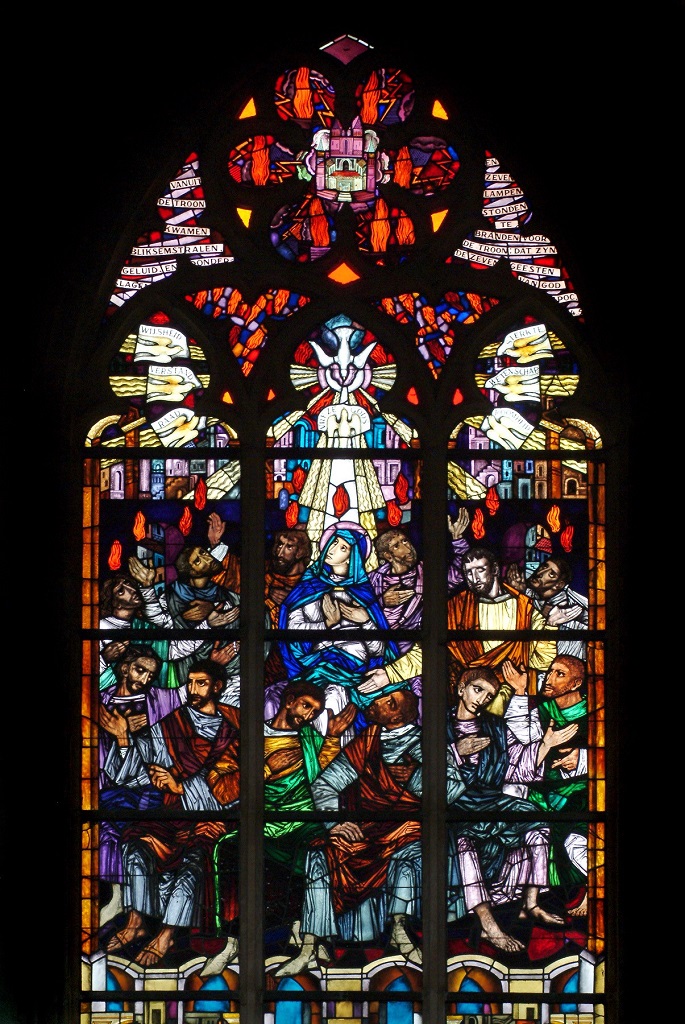
- At the confirmationThis is the sacrament in which baptism is confirmed. Hereby the confirmand expresses that he wants to live in the spirit of Christian faith. This is confirmed by the minister by anointing the confirmand. Confirmation is administered by a bishop or by a priest acting on his behalf. the faithful confirmand receives the power of God’s Holy SpiritThe active power of God in people. It inspires people to make God present in the world. Jesus was ‘filled with the Holy Spirit’ and thus showed in his speech and actions what God is like. People who allow the Holy Spirit to work in them also speak and act like God and Jesus at those moments. See also ‘Pentecost’.. This sacrament is illustrated by the story of PentecostThe feast, 50 days after Easter, which celebrates the descent of the Holy Spirit. This refers to the story from the Acts of the Apostles in which, after the death of Jesus, the disciples experience how the Holy Spirit shows itself in the form of flaming tongues. As a result, they come out of their seclusion and begin to preach in the languages of their hearers. In fact, this is how the beginning of the Church is celebrated., when God’s Spirit descends fierily over the apostles. In the centre is Mary, symmetrically surrounded by the twelve apostles. All of them receive a flame, “a tongue of fire”, above their heads. The seven gifts of the Holy Spirit, which they receive, are mentioned in the rays:
- left: “wisdom”, “reason” and “advice”,
- centre: underneath God’s hand, “the fear of God”,
- right: “strength”, “science” and “piety”.
- The tracery is bathed in a dominant red glow. The text can be translated as follows:
- left: “From / the throne / came / lightnings, / noise and thunder-/ bolts”
- centre: the (empty) throne of (invisible) God, accentuated by church towers, surrounded by seven flames and flashes of lighting
- right: “and / seven / lamps / stood / burning in front of / the throne; these are / the seven spirits / of God / Apoc. /4,5”
- The bottom zone: angels personifying the three divine virtues (1 Cor. 13:13).
- left: the Faith, armed with a sword and a coat of arms bearing a cross. Text: Corda fides fundat (Faith strengthens the heart).
- central, at the place of honour: Love as the chief virtue, with a pelican feeding two youngsters. Text: Ubi /caritas/ ibi Deus (Where there is charity, there is God).
- right: the Hope, with a firebird (phoenix) and an anchor, surrounded by water. Text: Spes erigit (Hope raises).
- The main theme is the baptismThrough this sacrament, a person becomes a member of the Church community of faith. The core of the event is a ritual washing, which is usually limited to sprinkling the head with water. Traditionally baptism is administered by a priest, but nowadays it is often also done by a deacon. of Christ by John the Baptist in the river Jordan, at which Jesus was indicated as “Son of God”. In this way at Christian baptism the person receiving baptism is adopted as a child of God. Someone who binds himself to God through baptism, wants to be freed from evil, which is an inextricable part of human nature. This initial sin is represented by Adam and Eve on both sides.
- left: the fall. In the tree of knowledge of good and evil (Gen. 2:16) there is the snake, whispering into Eve’s ear.
- centre: the baptism of Christ. The bright blue water has a magnificent colour.
- right: Adam and Eve are watching the baptism. Behind them a deer is drinking from a well, symbol of piety.
- tracery:
- top: the sign P, with underneath Christ as ruler of the world
- left: Noah’s ark with the peace dove
- right: the ark of the Covenant
- top zone:
- left: King David
- centre: the dove of the Holy Spirit
- right: a prophet with a dropping banderol
- bottom zone: the Red Sea crossingThe central point of a church with a cruciform floor plan. The crossing is the intersection between the longitudinal axis [the choir and the nave] and the transverse axis [the transept]. as the Old Testament prefiguration (Ex. 14:26-31)
- left: the pharaoh, his chariots and wagoners, flushed by the waters of the sea.
- centre: Moses, as the leader of the people, with on his head the two traditional horns, in fact beams of light, which here are exceptionally red.
- right: among the fleeing Jews there are a cat that looks very much like a teddy bear, and a woman with child on a donkey, preceded by her husband. This is an allusion to the flight into Egypt by Mary, the Child and Joseph.
- (A) The main scene is the wedding of Joseph and Mary, who reach for each other’s hands. (Even though in ecclesiastical circles opposition against this scene as an example of matrimony could be heard, the artist kept on defending it.) Mary, with a posy of white flowers in her hand, has cast down her eyes, while Joseph is looking at her longingly. In the background a Jewish priest is raising his hands in prayer. Next to him there are a pair of doves and above him also two doves.
- The main tableau is surrounded by four scenes with Joseph and Mary, each identified as “Mth. 1:18-25”, whereas each scene goes back to one single verse of this text.
- (B) top left: Joseph is sad when he sees Mary pregnant, but “since he was a righteous man, yet unwilling to expose her to shame, he decided to divorce her quietly” (v.19).
- (C) top right: Joseph’s dream in which an angel sets his mind at rest: “Such was his intention (to divorce her) when, behold, the angel of the Lord appeared to him in a dream and said, ‘Joseph, son of David, do not be afraid to take Mary your wife into your home. For it is through the Holy Spirit that this child has been conceived in her.’.” (v. 20).
- centre, left and right: an angel with flowers and an angel with vegetables.
- (D) bottom left: “When Joseph awoke, he did as the angel of the Lord had commanded him and took his wife into his home.” (v. 24)
- (E) bottom right: “He had no relations with her until she bore a son, and he named him Jesus.” Such is the only verse (v. 25) that gave the inspiration for this peaceful scene of family life during Mary’s pregnancy. Also here the artist permitted himself a far-reaching narrative interpretation, which contrasted sharply with the tendencies of abstraction arising in those days, mainly in religious stained-glass windows. Joseph, a mallet in his hand, stops his activities for a while and looks at Mary, who is spinning. In the foreground we see a few loafs of bread on a slab and a couple of jugs, in the background there is donkey in the adjacent stable. With this Jan Huet (the artist) wants to evoke the inner joy at the expectation of the Messiah in a climate of quietness and harmony.
- tracery, top:
- (G) Adam and Eve as the prototype of the natural bond between man and woman.
- (H) Lady Poverty and Saint Francis of Assisi as an example of a spiritual bond. Francis’s nickname ‘Il Poverello’ or ‘little poor man’ is derived from the Italian word povertà (poverty).
- zone bottom: typologically the proposal of marriage to Rebecca in three scenes:
- Left: Abraham’s eldest servant has been sent out with ten camels to find an appropriate wife for his son Isaac. At a well a pretty young girl carrying a jug on her shoulder, comes to get water and gives the man to drink and waters the camels. By this sign the servant realizes that this Rebecca has been sent by God (Gen. 24,1-27).
- Right: Rebecca also waters the camels (Gen. 24:19-20).
- Centre: Rebecca … alighted from her camel …covered herself with her veilHeadgear worn by female religious. Until the Second Vatican Council, all nuns wore wimples, which covered the entire hair and neck. Nowadays, the veil is usually worn on the hair.. …Then Isaac took Rebecca into his tent; he married her, and thus she became his wife. (Gen. 24:64–67)
- Here there are no Biblical, typological or symbolic side scenes. Only one scene fills the entire window, which causes a sudden compositional change with the former windows in the northern aisle. Such more modern composition can also be found as a parallel in the opposite stained-glass window in the southern aisle: The adoration of the shepherds, also by Jan Huet.
- The main New Testament theme is the return of the Prodigal Son, or better: the reconciliation between fatherPriest who is a member of a religious order. and son. The son is barefoot; his cane with gourd and his bag are in the foreground. Above father and son the resurrected Christ appears, showing the wounds in His hands and heart. He is surrounded by a group of six disciples, neatly arranged in two groups of three. In the story of the resurrectionThis is the core of the Christian faith, namely that Jesus rose from the grave on the third day after his death on the cross and lives on. This is celebrated at Easter. in which Jesus explicitly shows his wounds (John 20:20) he gives a mission to the apostles by saying: “Whose sins you forgive are forgiven them, and whose sins you retain are retained.” (v.23) Father and son are in the centre of a crown of thorns.
- Here the administration of the sacrament itself is shown, no Biblical scene. A priest with a green stoleA long strip of cloth worn around the neck by the priest, the two ends of which are of equal length at the front. The stole is worn during mass and the administration of the other sacraments. administers the last rites to an elderly, bedridden woman. This still reflects the pre-conciliar concept of the sacrament, as a rite administered to the dying. A clergyman is praying from a book. On the left we see a window and a door, top right there is a crucifix, bottom right a table with on it four wads of cotton wool, a brass bowl for holy waterWater that has been consecrated during the Easter vigil and which is used for baptisms and ritual blessings. and two burning candles on candleholders.
Because of the choice to have more daylight at the entrance of the church, the coloured zone of the stained-glass window was restricted to the inner panels.
